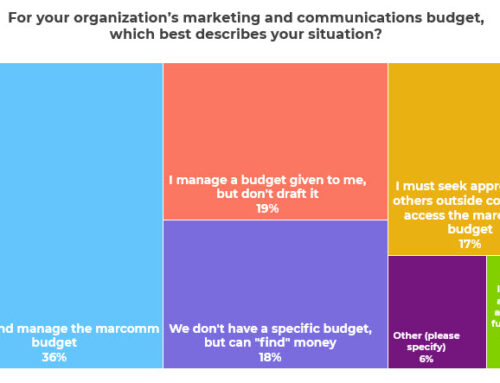Ever been asked to create a marketing strategy or a communications plan for your nonprofit without any further guidance? You aren’t alone!
Let’s sort it all out, so you can figure out what you really need to create.
First, let’s address the definitions. Right or wrong, marketing and communications are often used interchangeably in the nonprofit sector. Even if you are clear on the distinctions in your own mind, odds are extremely high that others around you use the words differently. You need to talk about what people really mean and what they are asking for when they request these documents from you.
I don’t want to start any arguments, but here’s how we generally use these terms, although we too use them interchangeably sometimes.
Marketing is primarily about strategy. What are the goals and objectives? Who is the primary target audience, what’s the message to those people, and which communications channels will best deliver that message? These are the questions you answer in a marketing strategy. You are making the decisions infrequently — you make them and stick to them for a while.
Communications is primarily about tactics. How, when and where are you communicating? You make these decisions much more frequently, constantly adjusting to match your current needs. When we talk about communications plans, we are most often referring to two documents, the Big Picture Communications Timeline and the Editorial Calendar.
Naturally, there’s a lot of overlap because you need both marketing and communications to effective.
Let’s look a little deeper into these documents.
What Goes into a Marketing Strategy
If you are creating a strategy, you’ll want to look at
- The 12 most common nonprofit marketing goals
- The 12 most common nonprofit marketing strategies
- The 12 most common nonprofit marketing objectives
- The 27 most common nonprofit marketing tactics
You’ll need to prioritize and say No to most of what you see on those lists, saying Yes to just a few (that’s basically the definition of being strategic). You’ll also need to define your target audiences and narrow your messaging and calls to action. You’ll usually articulate these as you make decisions on goals, strategies, and objectives.
Here’s a one-page Strategic Communications Plan Outline that we recommend. Yes, we are covering all the terminology bases! You can fill this in and create a document that is anywhere from 2-20 pages depending on how detailed you want to get.
What Goes in a Communications Plan
What if no one is particularly interested in talking about the organization-wide goals, strategies, and objectives? What if they are really asking you for a plan for what content you are going to create and what you are going to post in all of your different communications channels?
That’s where a few other documents come in . . .
I suggest that annually you create a Big Picture Communications Timeline.
The timeline maps out all of the events and milestones (both within and beyond your control) that will drive your communications in the coming year, along with your primary calls to action and the major storylines you want to share. It’s completed with all parts of the organization in mind: programs, fundraising, and marketing/communications.
Of course, you also need an Editorial Calendar. This is your day-to-day working plan. At a minimum, it outlines what you sharing, in what communications channels and when. You can add much more detail, including who is responsible for what, internal deadlines and workflows, and more. You’ll find lots of advice on nonprofit editorial calendars here.
Creative briefs are also very helpful when you are doing more project- or campaign-oriented planning.
So which document are you being asked to create? Who knows! Talk about the contents of this post with others and decide what you need to work on together. This communications plan decision tree could help too.






